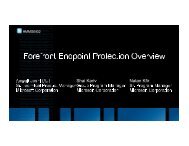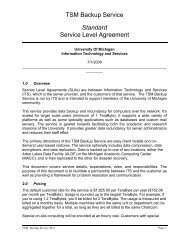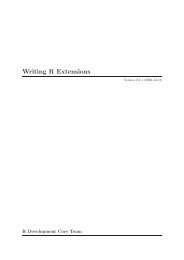What documentation exists for R?
What documentation exists for R?
What documentation exists for R?
You also want an ePaper? Increase the reach of your titles
YUMPU automatically turns print PDFs into web optimized ePapers that Google loves.
Chapter 6: R and Emacs 77<br />
6 R and Emacs<br />
6.1 Is there Emacs support <strong>for</strong> R?<br />
There is an Emacs package called ESS (“Emacs Speaks Statistics”) which provides a standard<br />
interface between statistical programs and statistical processes. It is intended to<br />
provide assistance <strong>for</strong> interactive statistical programming and data analysis. Languages<br />
supported include: S dialects (R, S 3/4, and S-Plus 3.x/4.x/5.x/6.x/7.x), LispStat dialects<br />
(XLispStat, ViSta), SAS, Stata, and BUGS.<br />
ESS grew out of the need <strong>for</strong> bug fixes and extensions to S-mode 4.8 (which was a GNU<br />
Emacs interface to S/S-Plus version 3 only). The current set of developers desired support<br />
<strong>for</strong> XEmacs, R, S4, and MS Windows. In addition, with new modes being developed <strong>for</strong> R,<br />
Stata, and SAS, it was felt that a unifying interface and framework <strong>for</strong> the user interface<br />
would benefit both the user and the developer, by helping both groups con<strong>for</strong>m to standard<br />
Emacs usage. The end result is an increase in efficiency <strong>for</strong> statistical programming and<br />
data analysis, over the usual tools.<br />
R support contains code <strong>for</strong> editing R source code (syntactic indentation and highlighting<br />
of source code, partial evaluations of code, loading and error-checking of code, and source<br />
code revision maintenance) and <strong>documentation</strong> (syntactic indentation and highlighting of<br />
source code, sending examples to running ESS process, and previewing), interacting with an<br />
inferior R process from within Emacs (command-line editing, searchable command history,<br />
command-line completion of R object and file names, quick access to object and search<br />
lists, transcript recording, and an interface to the help system), and transcript manipulation<br />
(recording and saving transcript files, manipulating and editing saved transcripts, and reevaluating<br />
commands from transcript files).<br />
The latest stable version of ESS are available via CRAN or the ESS web page. The HTML<br />
version of the <strong>documentation</strong> can be found at http://stat.ethz.ch/ESS/.<br />
ESS comes with detailed installation instructions.<br />
For help with ESS, send email to ESS-help@stat.math.ethz.ch.<br />
Please send bug reports and suggestions on ESS to ESS-bugs@stat.math.ethz.ch. The<br />
easiest way to do this from is within Emacs by typing M-x ess-submit-bug-report or<br />
using the [ESS] or [iESS] pulldown menus.<br />
6.2 Should I run R from within Emacs?<br />
Yes, definitely. Inferior R mode provides a readline/history mechanism, object name completion,<br />
and syntax-based highlighting of the interaction buffer using Font Lock mode, as<br />
well as a very convenient interface to the R help system.<br />
Of course, it also integrates nicely with the mechanisms <strong>for</strong> editing R source using Emacs.<br />
One can write code in one Emacs buffer and send whole or parts of it <strong>for</strong> execution to R;<br />
this is helpful <strong>for</strong> both data analysis and programming. One can also seamlessly integrate<br />
with a revision control system, in order to maintain a log of changes in your programs and<br />
data, as well as to allow <strong>for</strong> the retrieval of past versions of the code.<br />
In addition, it allows you to keep a record of your session, which can also be used <strong>for</strong><br />
error recovery through the use of the transcript mode.








